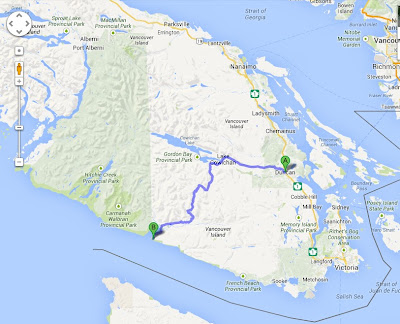This past weekend, my fella and I took one of our favourite drives, across the island to Port Renfrew.
It's a beautiful drive with lots of amazing scenery along the way and, when you get to Port Renfrew, beaches so amazing I can't begin to describe them.
Two of my very favourite beaches are there; the long sweeping crescent of sand near the river's mouth, and Botanical Beach, in Juan de Fuca Provincial Park. We visited both beaches on Saturday but I'm writing to tell you about Botanical Beach because it is so very unique.
The trail to Botanical Beach is like a journey through Middle Earth. The trees have been sculpted into curious, enchanting shapes by wind and weather. They bend and reach toward the sun and, when an old tree falls, new trees twine around it, creating a fantastic tangle of roots and greenery.
The park is left as much as possible in its natural state.
Unless they fall and block the trail, dead trees are left standing. They provide homes and food for the animals in the forest, and magnificent perches from which fierce looking eagles can survey the shore.
Tangles of roots protrude above the worn soil of the trail, which is occasionally bridged to protect those roots from damage or to help hikers over muddy spots.
I tend to dawdle along the trail, enjoying the shapes, the play of light and shadow, and the glimpses of ocean showing through the trees, but there is always the lure of the beach itself calling me onward.
Botanical Beach looks at first glance to be totally inhospitable. It has broad shelves of sandstone that once formed around harder rocks now rolled away by the action of the waves, leaving carved hollows and almost spherical pools. In other places ridges of shale and quartz jut up through black basalt.
Inshore, there are expanses of gravel and mussel shell, worked by the endless motion of the sea into flat, smooth shingle.
Waves crash upon the hard shore here, having gathered force across thousands of kilometers of open ocean. Tides change rapidly. The water is brutally cold and swirls in whirlpools. There's an undertow.
Yet within all of these hard edges and inhospitable conditions can be found something truly remarkable: The pockets in these lunar-looking stones hold water as the tide recedes, creating hundreds of tidal pools, in which all manner of intertidal life flourishes.
Waves crash upon the hard shore here, having gathered force across thousands of kilometers of open ocean. Tides change rapidly. The water is brutally cold and swirls in whirlpools. There's an undertow.
Yet within all of these hard edges and inhospitable conditions can be found something truly remarkable: The pockets in these lunar-looking stones hold water as the tide recedes, creating hundreds of tidal pools, in which all manner of intertidal life flourishes.
People travel from all over the world to see these natural aquariums, and are astounded by both the grand scale of this wild landscape and the diversity of life found within the pools.
Here are a few things I saw on this weekend's trip to the beach:
Here are a few things I saw on this weekend's trip to the beach:
Sea urchins:
These fellows like to find pockets in the rock and nestle in. They'll even work to sculpt the rock themselves in order to make the perfect hidey-hole. Although their spiny exteriors belie it, sea urchins are really tasty. Many of the birds that live on or near the beach enjoy them, as do seals. If it were not against the law to remove them from the beach, I'm sure humans would too!
Coral:
There are actually several kinds of coral native to our island's west coast beaches. This purple one is the most common at Botanical Beach but there are also some less common upright, branching types.
Rock fish:
This little fellow was about three inches long and so well camouflaged that, at first, I didn't see him hiding in the coral. There were a great many other fish in the pools too.
Crabs:
Do you see the tiny hermit crab in this photo (near the left edge)? He was less than 1/2 inch across, shell and all, and busily working his way through the shallows. We have many small rock crabs in our intertidal zones. Although it is discouraged at the park, kids love turning over stones to watch them scurry for cover.
Barnacles and Limpets:
There are several types of both barnacle and limpet on our beaches. All are edible. These barnacles were particularly large, some reaching a length of two inches or more.
Mussels:
Mussels attach themselves to the stones all over Botanical Beach, in some places forming a vast carpet of blue. When they die, their shells are gradually broken and polished by the action of wave and stone. There is so much mussel shell on the beach that some of the shingle areas appear to be coloured bluish purple.
Salt:
Sea water gathers in shallow hollows of the rocky shore and then evaporates, leaving deposits of salt behind. Like many of the resources on the beach, this salt was long prized by the area's First Nations.
Small wonder this beach is, and has always been, a treasure to people here. I love it and find myself drawn back time and again. I hope you enjoyed it too.
Please click on any of the photos to be taken to a larger view.
______________________________
Map sourced from Google Maps.


















